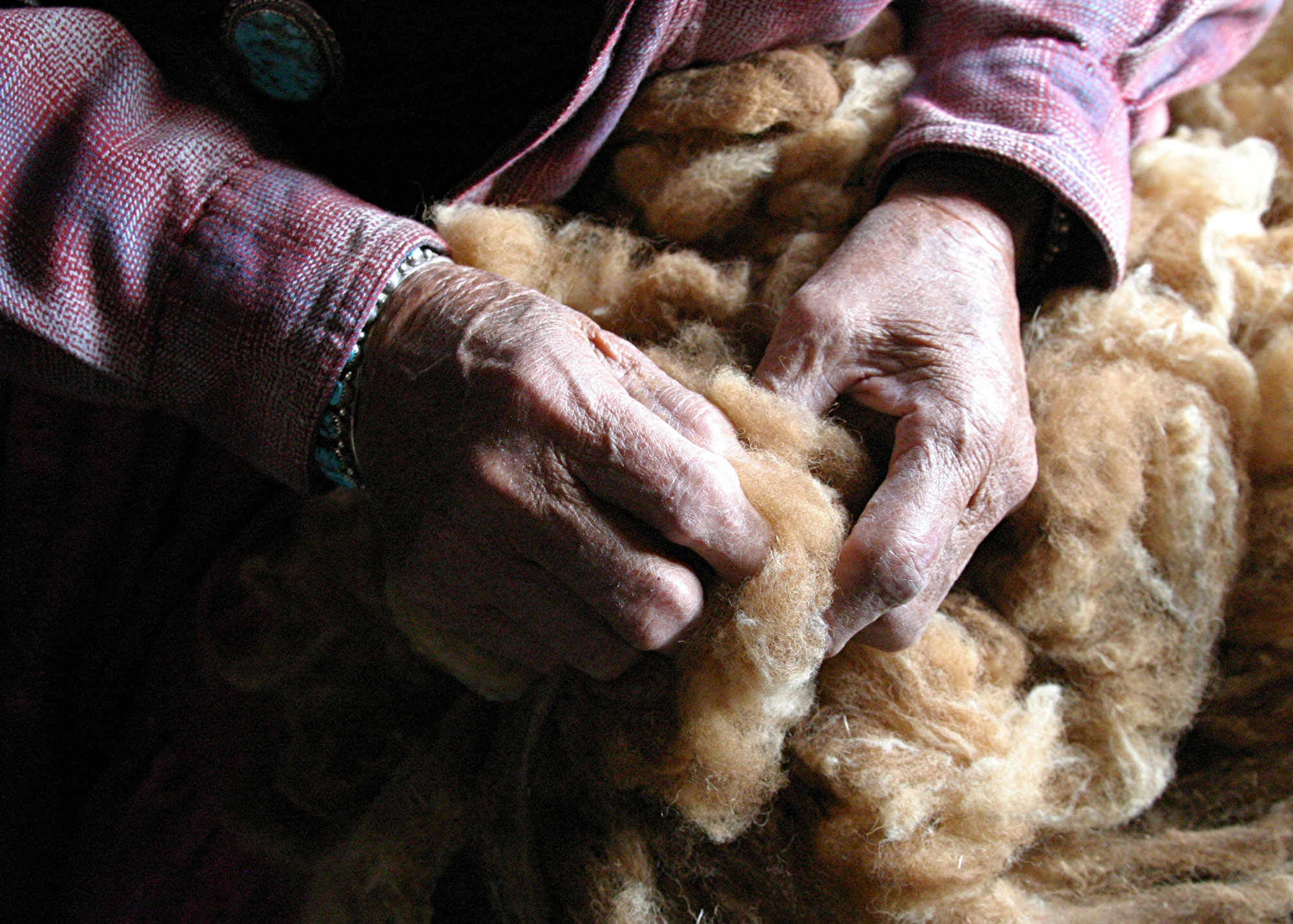
29 Dec Grandmother Weavers
THE BABY GIRL'S HANDS WERE CAREFULLY WRAPPED IN SPIDER WEBS as the Navajo blessing ceremony began. Firmly rubbing each little hand, the Medicine Man chanted pleas for Spider Woman to bless this baby with … the gift of weaving.
When the Navajo baby grew into a young woman, she prepared for her Beauty Way ceremony — a four- to seven-day coming-of-age ritual. Again, the Medicine Man was summoned. She was taught the responsibilities and obligations of a Navajo (Diné) woman in a matriarchal society. She learned her lesson well and became physically strong, ‘walked in beauty,’ which is to honor the land and restore balance and harmony in her life (Hozhó). She held the sacred stories within her heart, and learned to weave. For years she has tended a flock of sheep, sheared them, cleaned, combed, spun and woven the wool into beauty. Now she has grown old and is a beloved, accomplished grandmother weaver. Nowhere is the connection between the physical world, the legendary world and creativity more clearly linked.
On the vast Navajo Nation near the Four Corners region where New Mexico, Arizona, Utah and Colorado conjoin, this culture is so old and isolated and rare that its customs seem mysterious. The Navajo honor Mother Earth, Father Sky and all of nature is sacred. According to legend, Spider Woman’s creative powers were given to them through the art of weaving. The first loom was said to be made by Spider Man of sky and earth, sun, lightning, rain, white shell, crystal, turquoise and abalone.
Just as a line follows a spider leaving her web, many Navajo weavers carry a “spirit-line” out to the edge of a finished weaving to pay tribute to Spider Woman and to prevent the weaver’s spirit or creative energy from being trapped in the weaving. Spider Woman is called upon daily to bless the weaving and the weaver.
In a society that is increasingly bi-cultural, it is the choice of the Navajo girl to participate in the ceremonies and the tradition of weaving.
We journeyed to northern New Mexico in search of the weavers, in particular the shimas, or grandmothers who make the Navajo rugs, which have been coveted and collected worldwide. These weavers, as Navajo babies, were swaddled on cradleboards near their mother’s looms, where often the first sound they heard was the soothing rhythmic thump of the hand-held wooden batten on the weft as mothers and grandmothers spent their days quietly, peacefully spinning. Those weavings were beautiful, intricate patterns that became art and sustained their families.
“The grandmother weavers are very respected and honored not only because of the knowledge they have as weavers, but their role in traditional Navajo society as grandmothers, mothers, sisters and aunts,” said Wendy Weston, a Navajo Indian and director of American Indian Relations at the Heard Museum in Phoenix.
In the Toadlena Trading Post near Shiprock, a tiny Navajo weaver, eroded by years, silently approaches trader Mark Winter. He calls out, “Shima,” tenderly wraps her in a hug, and leans down to kiss the top of her scarfed head. Both are visibly warmed by the encounter. It’s more than a symbiotic business relationship. She is one of his beloved grandmother master weavers.
At Winter’s trading post, which celebrated its 100th anniversary in June, 2009, Virginia Deal, who is in her 80s and purportedly the best living Navajo weaver, spins yarn onto a spindle from a fluffy bundle of cleaned and combed wool. It could take five and a half months for her to spin 10 miles of yarn, as fine and smooth as thread, for one rug. As a little girl she longed to weave but wasn’t allowed any wool — a precious commodity. With impish pride she says, “I [stole] wool from my mother, and [hid] to do the weaving. I [taught] myself to weave.”
Pam Farley Brown, a 25-year-old weaver, sits on the trading post floor near Virginia with a small loom and weaves, just as she has with her grandmother. Comfortable with the generation gap, they quietly communicate in their native Navajo, which is still largely spoken throughout the region. The art of weaving among the Navajo has been passed down from grandmother to mother to granddaughter since the 1700s when, historians generally agree, they learned to weave from their Ancestral Pueblo neighbors. It seems that Navajo weaving is the culmination of the upright loom and weaving techniques of the Ancestral Puebloan culture, the wool introduced by the Spanish, and the legends of the Navajo.
As the art form developed, trading posts were built in the region between 1870-1880. Traders encouraged higher quality and distinctive weaving patterns. Seven weaving districts named for the trading posts emerged, each with distinctive design elements and colors developed by the weavers and influenced by the traders. It’s a relationship that continues today.
We have set out to meet master weaver, Evelyn George, an elegant Navajo grandmother who raises her own sheep, shears them, washes the wool, combs, spins and weaves it. This trip will involve a team: five Belaganas (Anglos) including myself and a photographer, and two Navajos. Mark Winter and Linda LaRouche from the Toadlena Trading Post in the Two Grey Hills region, where weavings are distinguished by natural, undyed wool, have graciously made arrangements and will help bridge the communication and cultural gap. The older weavers speak halting English, if at all, and most have no telephone, so connecting and communicating is a challenge.
Mark and Linda gather some groceries: a 25-pound cloth sack of flour, can of coffee and bag of cookies. Virginia Deal will direct us to her friend Evelyn’s home. Pam, the young weaver, wishes to see Evelyn’s golden sheep — the source of the rare and coveted golden wool.
We drive away from the trading post, nestled up against the Chuska Mountains, in a raging 60-mph wind that blasts sand across the huge, barren high desert. A short, rough detour leads us to an unexcavated Chacoan outlier site, nothing more than a mound of sand with pre-Puebloan pottery shards littering the ground. We tread cautiously around the untrammeled ancient history. The outlier is on the road used by Chacoans 1,000 years ago to carry an estimated 200,000 logs from the Chuska Mountains to the site of the ancient Chaco Canyon civilization.
Back on the trail, Virginia Deal silently and vaguely points periodically out at a new brutal, two-rut trail for our driver, LA, to follow. As we bounce and bang along the trail, he develops a twitch in his clenched jaw, but drives on. Pam and Virginia laugh conspiratorially over something Virginia has said in Navajo.
Finally, on that high desert moonscape, a small grouping of buildings appears: a square house, octagonal hooghan, rectangular sheep shed and corral. Evelyn George meets us at the door. Striking in her midnight blue velveteen blouse, cotton skirt and turquoise jewelry, Evelyn politely greets us. Then she sits on one of two twin beds in the living room, close to her friend, Virginia. Heads together, a hand on each other’s knee, both in their 80s, they speak softly in their beautiful shared dialect.
Linda quietly explains that Evelyn, in her simple surroundings, is one of the more opulent weavers. Many have no running water, electricity or telephone. Her place is neat and tidy and her life is organized.
When the Navajo women have had sufficient time to catch up, Winter urges Evelyn to take us to the loom in her bedroom. In broken English, she says that she dreams of wool and patterns and colors or lies awake nights planning her weaving. She too, as a child was spared no wool. When herding sheep, she gathered the wool that snagged in the brush, smuggled it in her pockets and hid to weave. She admits to having herded the sheep back and forth through the underbrush to collect more wool.
Evelyn sits on a worn pillow in front of her loom, where she has spent countless hours … months … years. The rhythm begins. With deft and nimble fingers she weaves and thumps the long, narrow wooden batten, which she carved while herding sheep. It took two months to prepare each color of wool, and two months to accomplish the mere 4 inches of weaving on the loom. With unceasing diligence she creates a mysterious work of enduring art. Clearly, the astonishing price tag on a quality Navajo rug is justifiable — even modest.
Prices are established according to the skill of the weaver, detail of the design, size, age, rarity, beauty and historic significance. Weavings with the finest weft (number of horizontal threads per inch) are called tapestries and are worth thousands of dollars. Mark Winter advises Sotheby’s on Southwest textiles and says an old Navajo weaving can bring $100,000 or more.
The Trading Post has been the primary outlet for Navajo rugs. After as much as a year of preparing the wool and weaving, a finished rug is removed from the loom and taken directly to the trader who is the first to see the new creation. The weaver basks in his praise. Tom Wheeler, a kind and professional fourth-generation trader from Hogback Trading Post near Farmington, says he looks at each rug as art and sees beauty in each.
Designer John Kurtz of New Moon Rugs says, “The classic period Navajo blankets represent one of the pinnacles of North American art and design. Even more exceptionally, it was achieved by women, anonymous Native American women.”
Due to Winter’s work, many weavers are no longer anonymous. Winter’s passion for collecting Navajo textiles turned into a quest for knowledge about the weavers and their lineage and a drive to record their history. He made his fortune as a Southwest weaving dealer and now he’s spending it to perpetuate the tradition of weaving among the Navajo. He lectures extensively at universities and museums, sharing his expertise.
Kathie Curley, from the Navajo Nation Department of Tourism said, “Mark Winter not only inspires excellence in today’s Toadlena weavers, he’s responsible for the encouragement and inspiration for the next generation. Without [him], I feel the Navajo Nation would see this style quickly begin to fade away. The weavers would find it difficult to make a living, new generations would not pursue weaving and the history would be lost.”
Traders have served an important role in Navajo society since the 1800s as counselors, bankers, doctors, lawyers, postmasters and teachers, as well as their official role as buyers of weavings and silver jewelry, providers of pawn services and suppliers of goods. Navajo artist Anthony Chee Emerson’s etchings of Navajos depict their everyday lives and in each scene is a “trading post guy,” as he calls them, in a helping role: the wife as the teacher or the trader helping with harvest because he owned the truck. Emerson said, “He [the trader] could always go to the Navajo level, speak the language, joke around.”
Mark and Linda visit with Evelyn affectionately. Mark asks about her sheep and in broken English she communicates that she has gathered them for us to see. She dons a flannel shirt over her blouse and ties a scarf over her hair, which has been carefully tied up in the traditional Navajo knot. We boldly tuck into the wind, squint to keep the sand from our eyes and walk across the barren earth to the barnyard. Evelyn walks serenely into the storm, accustomed to dealing with the immediacy of nature’s challenges. Gathered there is the most beautiful herd of 76 sheep — their fleeces shades of browns, gray, cream and gold, all the colors of a Two Grey Hills Navajo rug. Four sheep dogs worry around them, watching Virginia for a sign. She wanders among them, a loving shepherd, skirt billowing in the wind. The sheep are her pride, her love, her life. She says, “Sheep is life.” Indeed.
After we admire her sheep, Evelyn turns them out and leads us to the hooghan where she washes her wool, cleans and combs it. The hooghan, a holy place where the Navajo hold their ceremonies, is an octagonal building with a dirt floor, which, she explains, allows them to be nearer to Mother Earth. The light filters through the small window and she pulls a sheet from a mound on the floor revealing voluptuous bundles of soft, clean, wool in natural, luminous colors. She caresses it. In a strong, clear voice she translates the blessing song weavers sing when they begin to weave each day: “Blessing my weaving; Blessing my hand; Blessing my head; Blessing for Spider Lady, Spider Man.”
I sit beside Evelyn on a cot and ask about the spider web blessing. She said she received the blessing and has, herself, performed it with webs collected in a tissue. In her burnished, work-worn hands, smooth from the lanolin in her wool, she takes my right hand in hers and firmly rubs it, chanting the Navajo blessing, then repeats it with the left. My hands warm, and I am honored.
It is a privilege to witness the pure and simple lifestyle of a Navajo grandmother weaver. She honors Mother Earth, Father Sun, Spider Woman, Spider Man and, indeed, all of creation. She embraces the sacred earth — embodies it, really — as she lives in harmony with it.
Leaving the weaver’s ranch, the raging wind has turned the landscape different shades of grays and browns. Even the cerulean blue of the New Mexico sky is grayed from the blowing sand. The sunset, filtered through the sandstorm, glows the color of the golden fleece. The earth is the tone of a Two Grey Hills Navajo rug. Our senses are filled with the understanding that in each Navajo rug are days of songs and prayers for blessings on the weaving and the weaver; nights of dreaming of designs and colors; and hundreds of hours of patient, methodical carding, spinning and weaving on a loom that is treated with a sacred respect. The shimas — the grandmother weavers — burnished with age, are in their golden years and their hearts still beat to the rhythm of the loom. Their lives are woven as simply and beautifully as a Navajo rug.
- Discovering the lands of ancient people — the Pueblo Alto Complex, was an important junction of several prehistoric roads. It can only be accessed by climbing through a cleft in the sandstone cliff behind great house Pueblo Bonito in Chaco Canyon.
- Legend states that “Spider Woman” first taught the Navajo women to weave on a loom.
- Evelyn herds her 76 sheep in 60 MPH winds.
- Grandmother weavers, Virginia Deal and Ella Shorty greet each other at the Toadlena Trading Post.
- Master weaver Evelyn George.
- Ancient pottery shards litter the landscape near Shiprock.
- Four-foot tall doorways lead through Pueblo Bonito, the center of the Chacoan world.







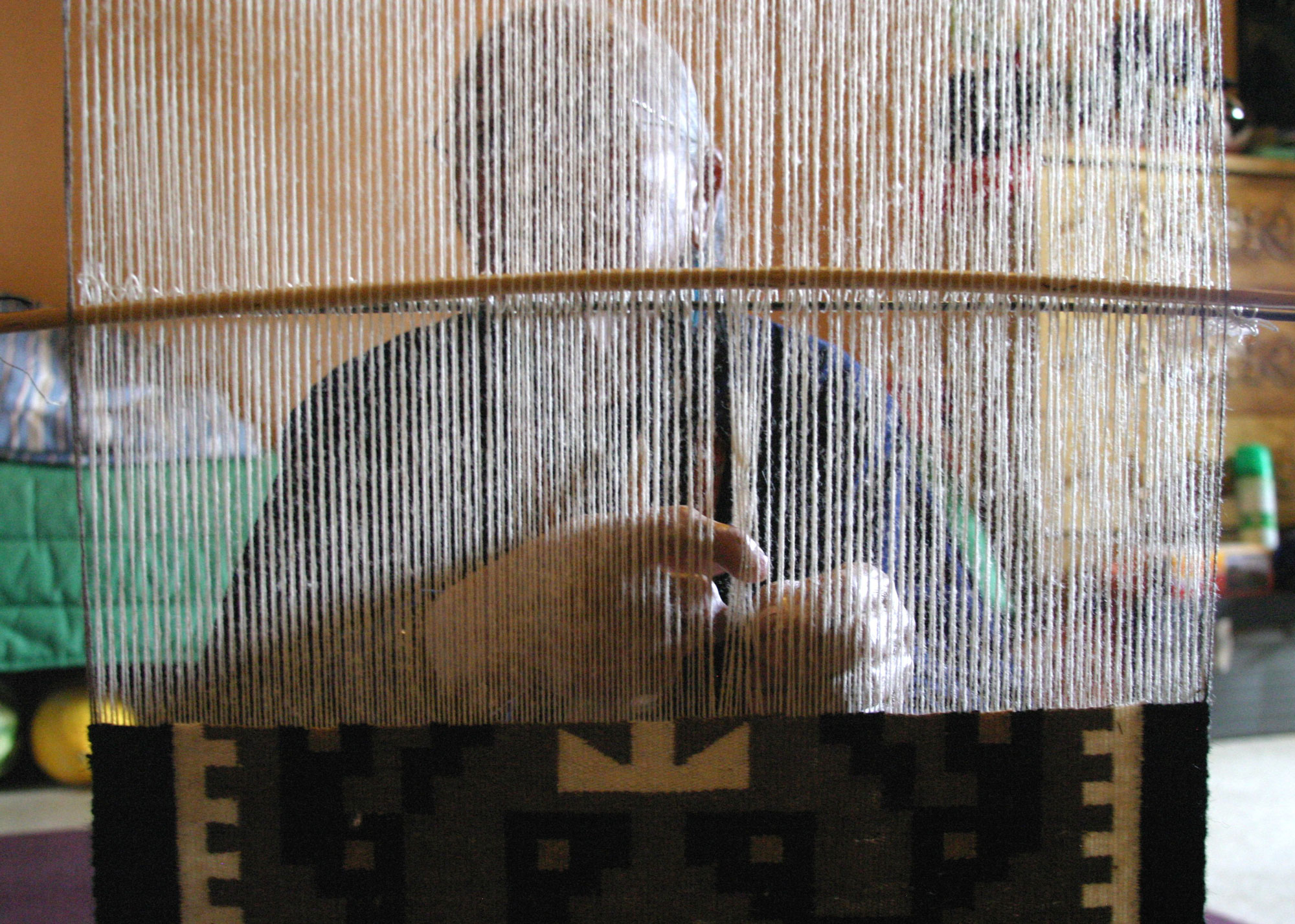
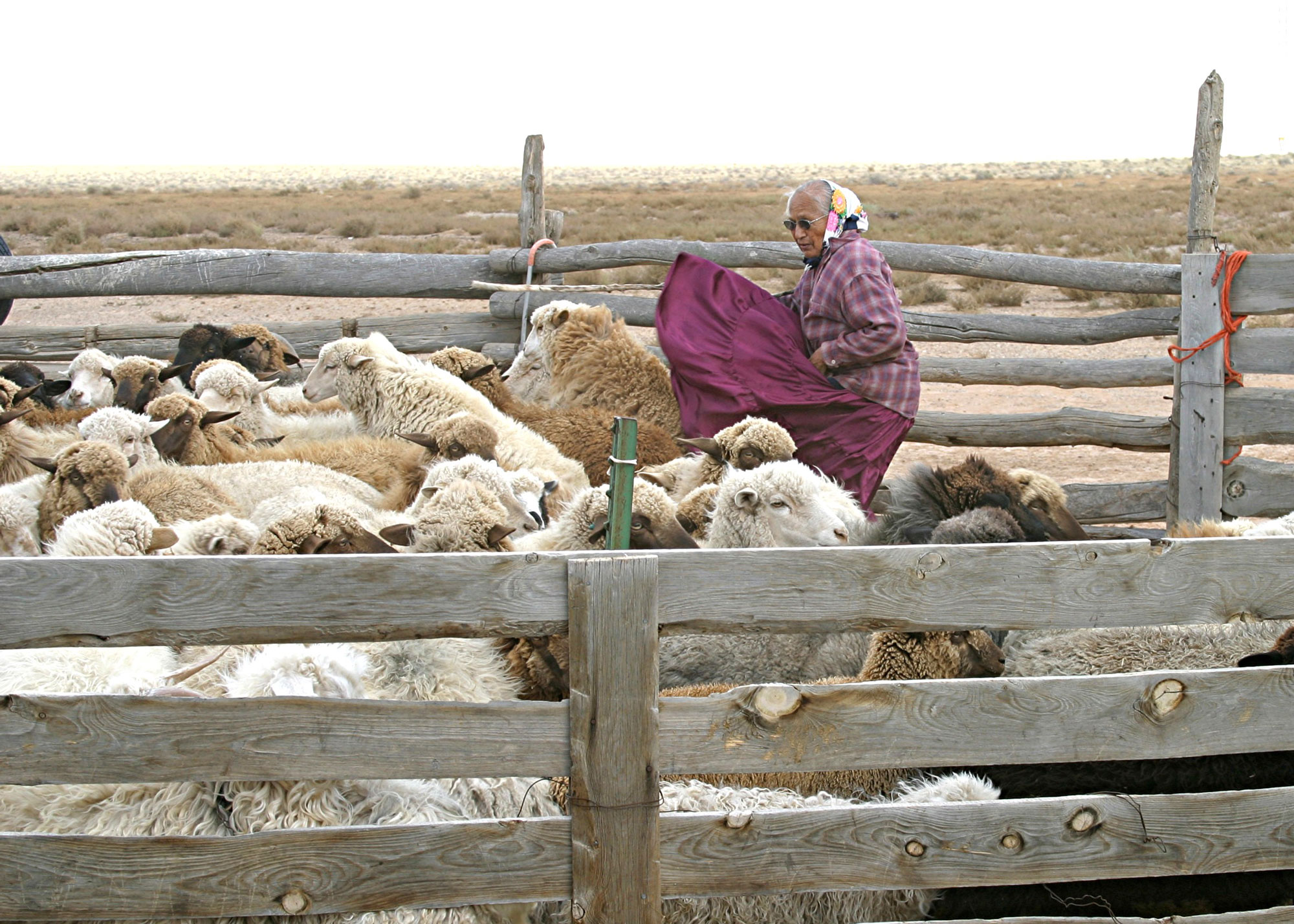
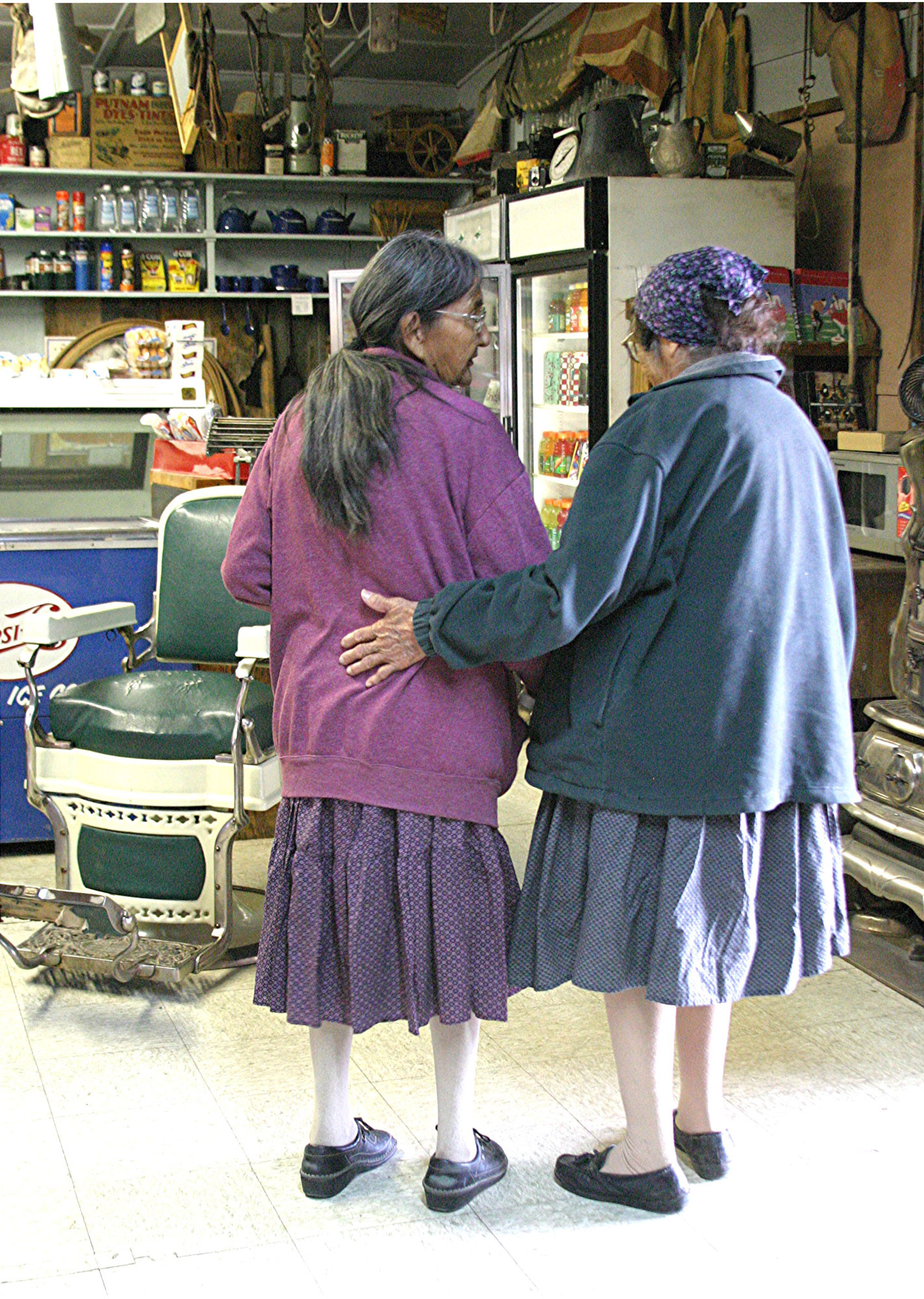
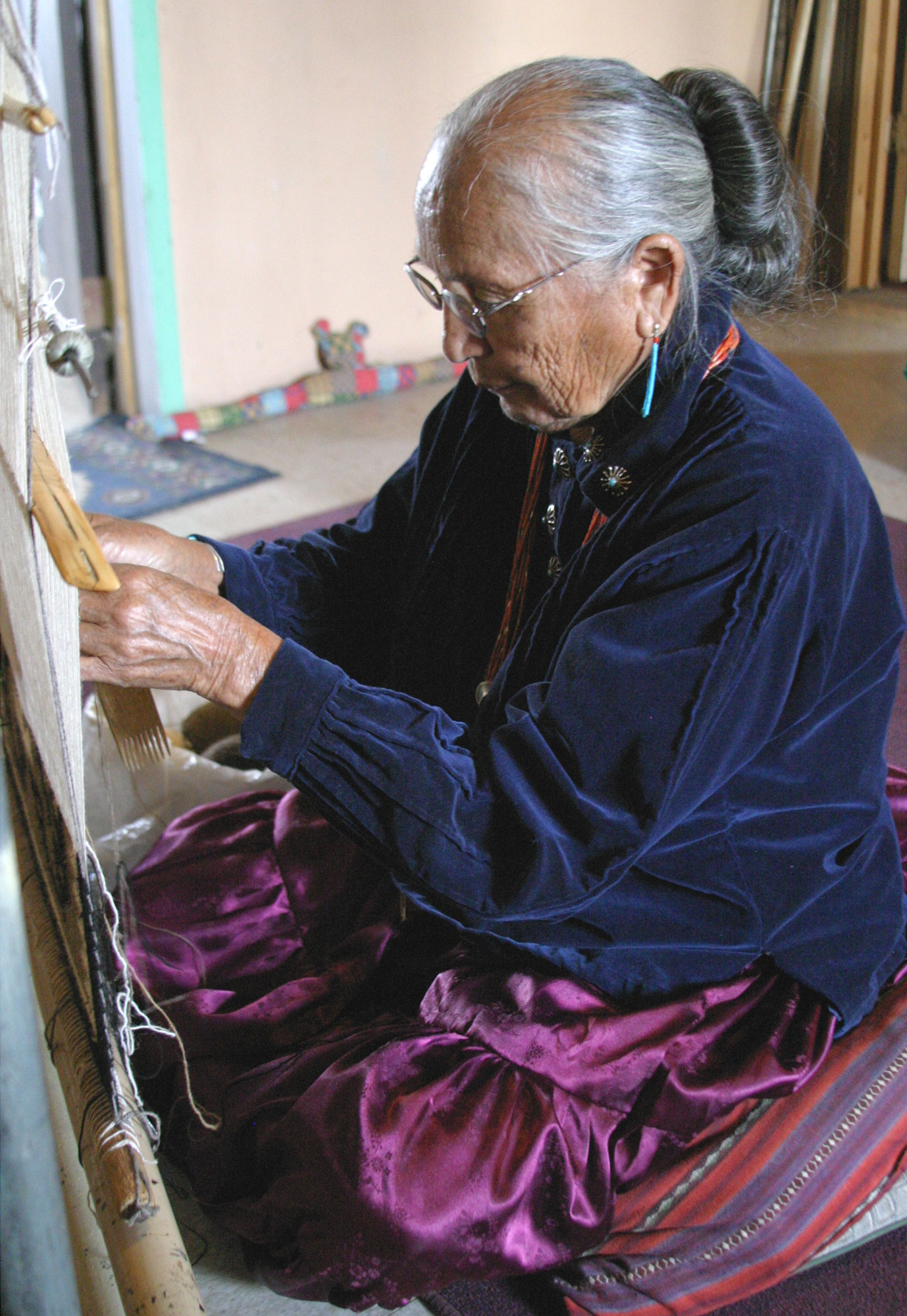
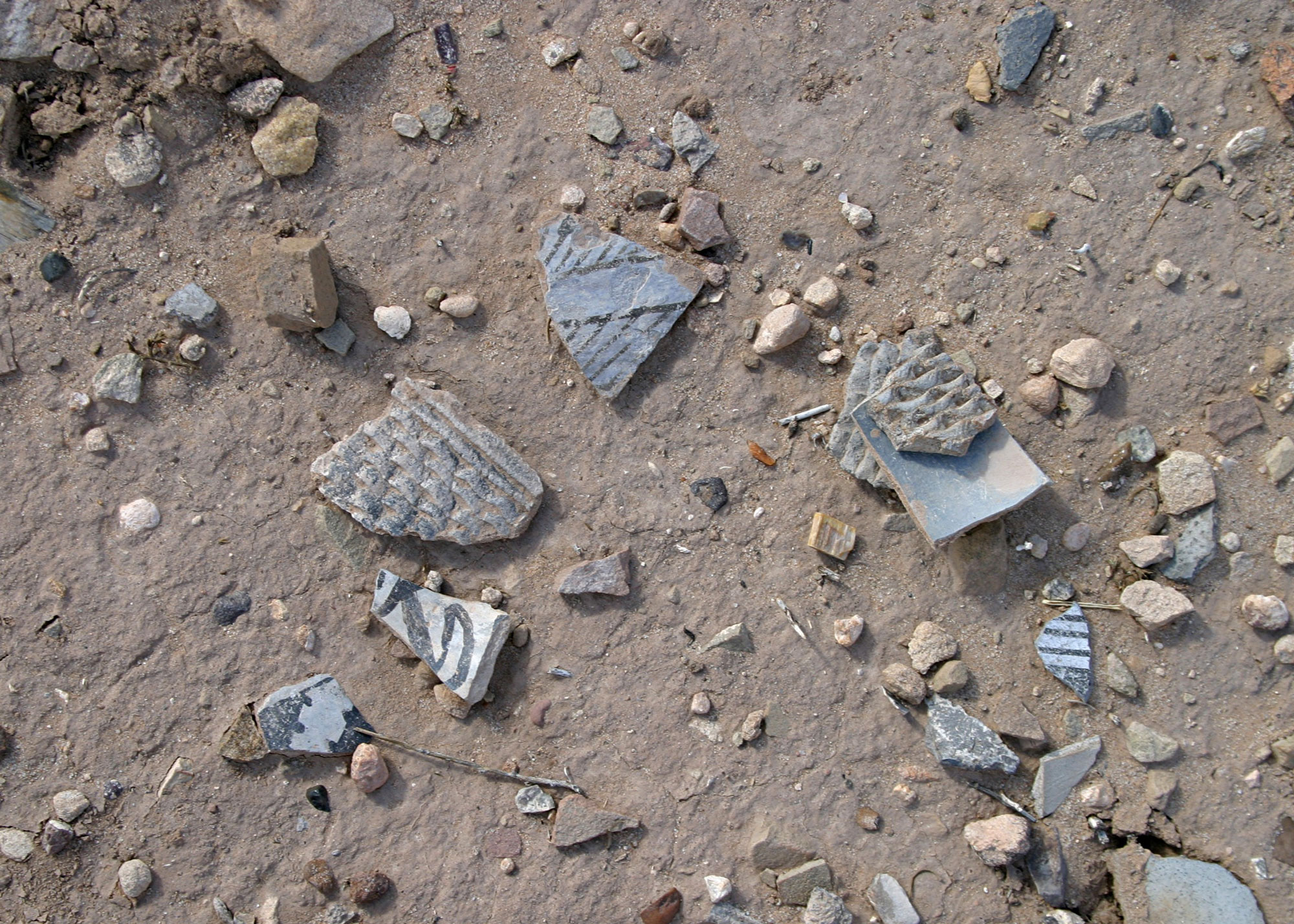
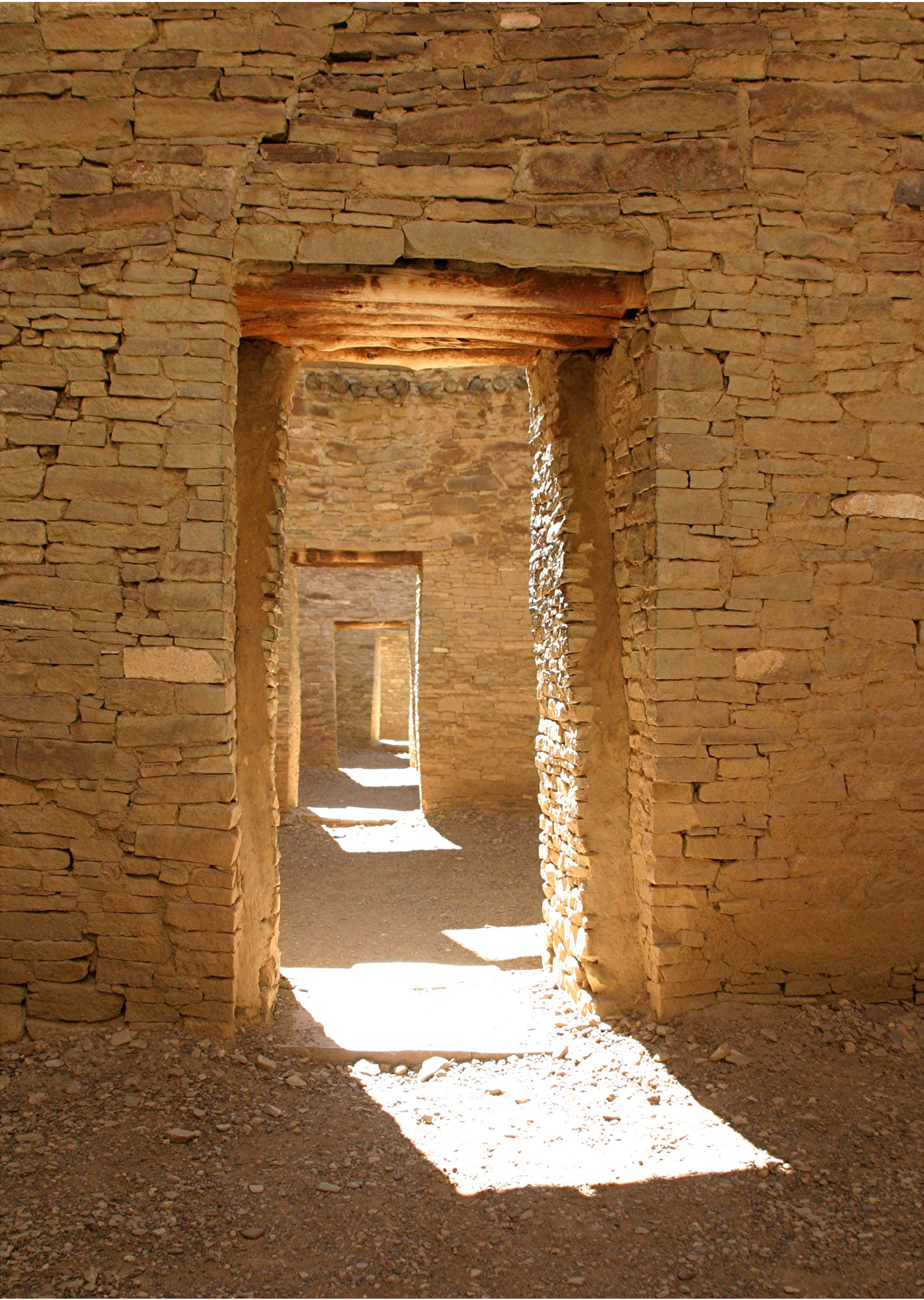
No Comments